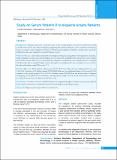Please use this identifier to cite or link to this item:
https://hdl.handle.net/20.500.14356/1427Full metadata record
| DC Field | Value | Language |
|---|---|---|
| dc.contributor.author | Marahatta, Suchana | - |
| dc.contributor.author | Agrawal, Sudha | - |
| dc.contributor.author | Khan, Seraj | - |
| dc.date.accessioned | 2023-05-10T10:41:51Z | - |
| dc.date.available | 2023-05-10T10:41:51Z | - |
| dc.date.issued | 2019 | - |
| dc.identifier.citation | MarahattaS., AgrawalS., & KhanS. (2019). Study on Serum Vitamin D in Alopecia Areata Patients: Alopecia areata and vitamin D: is there any association?. Journal of Nepal Health Research Council, 17(01), 21-25. https://doi.org/10.33314/jnhrc.v17i01.1475 | en_US |
| dc.identifier.issn | Print ISSN: 1727-5482; Online ISSN: 1999-6217 | - |
| dc.identifier.uri | http://103.69.126.140:8080/handle/20.500.14356/1427 | - |
| dc.description | Original Article | en_US |
| dc.description.abstract | Abstract Background: Alopecia areata is the commonest cause of non-scarring alopecia. Few previous studies have found correlation between AA and vitamin D deficiency, suggesting that vitamin D deficiency can be a risk factor for Alopecia areata. To compare serum vitamin D level between Alopecia areata patients and healthy controls; and to assess the relation between serum vitamin D levels and AA disease severity. Methods: This case control study included 30 newly diagnosed Alopecia areata patients. Thorough history was taken, detail examination was done and relevant findings were recorded in the standardized pro-forma. Their serum vitamin D (25-hydroxyvitamin D) levels were determined by competitive chemiluminescence methods; and were compared with that of age and sex matched healthy controls. Chi square test and Spearman’s rho correlation test were used for the inferential statistics using SPSS version 11.5. Results: There were 30 AA patients with mean age 28.37+10.07 years. Mean Severity of Alopecia Tool score was 3.56+3.50. Prevalence of 25-hydroxyvitamin D [25(OH)D] deficiency was significantly higher in AA group (83.3%) compared to the control group (53.3%) (P=0.01). Similarly, serum 25(OH)D level was reduced more in Alopecia areata group (12.84, IQR=8.87-20.47) than the control group (29.5, IQR=19.85-41.27) (P=0.06). There was inverse co-relation between serum 25(OH)D level and SALT score. Conclusions: Prevalence of serum 25(OH)D deficiency was significantly higher in Alopecia areata group compared to the control, with inverse co-relation between its level and Alopecia areata disease severity. Keywords: Alopecia areata; Nepal; SALT Score; Vitamin D. | en_US |
| dc.language.iso | en | en_US |
| dc.publisher | Nepal Health Research Council | en_US |
| dc.relation.ispartofseries | Jan-March, 2019;1475 | - |
| dc.subject | Alopecia areata | en_US |
| dc.subject | Nepal | en_US |
| dc.subject | SALT Score | en_US |
| dc.subject | Vitamin D | en_US |
| dc.title | Study on Serum Vitamin D in Alopecia Areata Patients | en_US |
| dc.type | Journal Article | en_US |
| local.journal.category | Original Article | - |
| Appears in Collections: | Vol. 17 No. 1 Issue 42 Jan - Mar 2019 | |
Files in This Item:
| File | Description | Size | Format | |
|---|---|---|---|---|
| 1475-Article Text-9263-1-10-20190429.pdf | Fulltext Download | 291.39 kB | Adobe PDF |  View/Open |
Items in DSpace are protected by copyright, with all rights reserved, unless otherwise indicated.
